人教版(2019)选择性必修第一册Unit 4 Body Language Reading and Thinking课件(共27张,内嵌视频)
文档属性
| 名称 | 人教版(2019)选择性必修第一册Unit 4 Body Language Reading and Thinking课件(共27张,内嵌视频) | 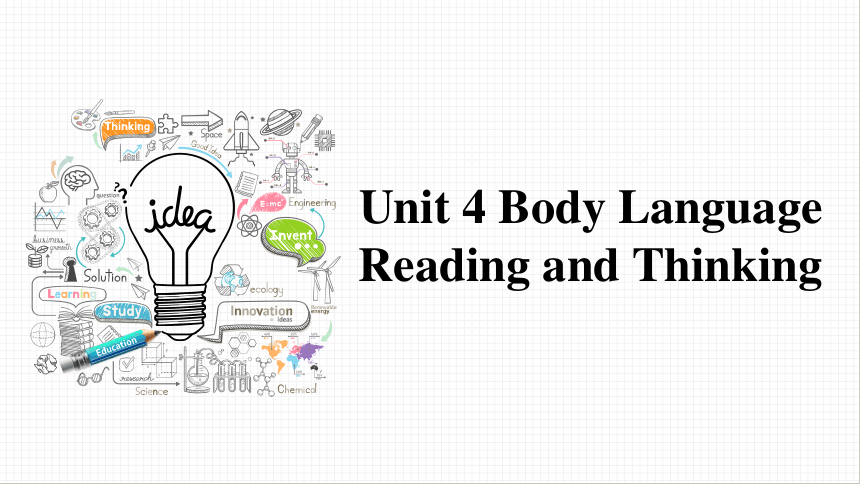 | |
| 格式 | pptx | ||
| 文件大小 | 62.7MB | ||
| 资源类型 | 教案 | ||
| 版本资源 | 人教版(2019) | ||
| 科目 | 英语 | ||
| 更新时间 | 2024-10-11 16:21:52 | ||
图片预览

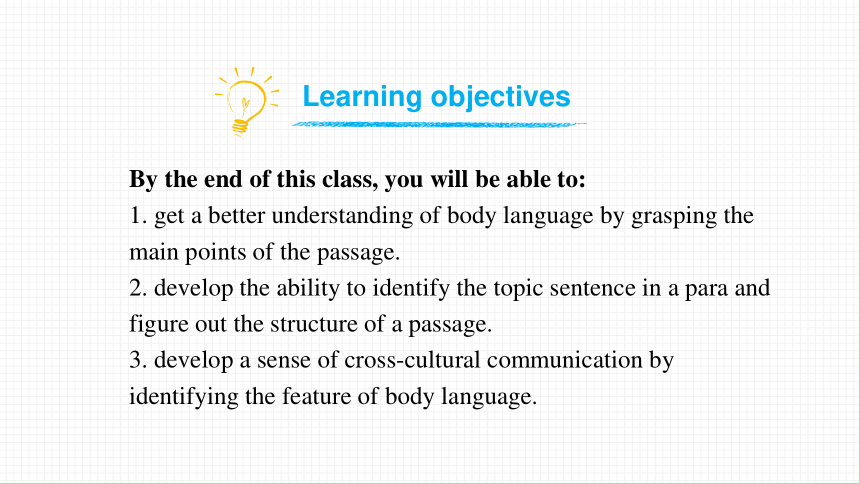
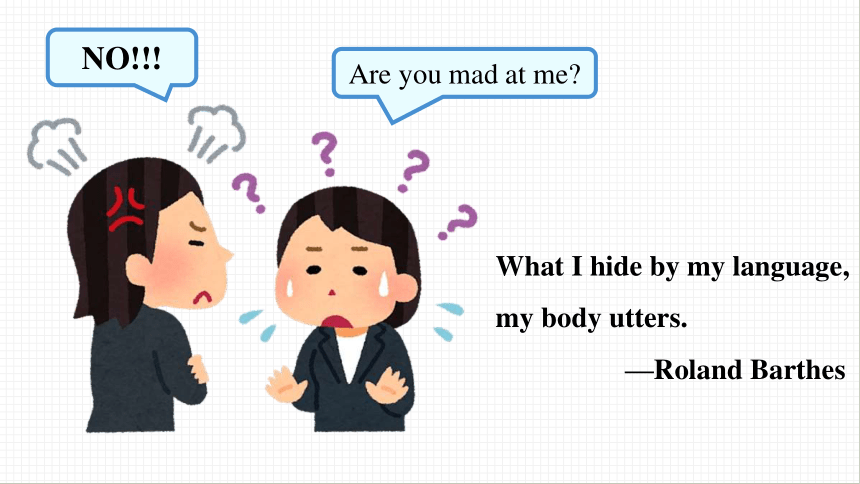

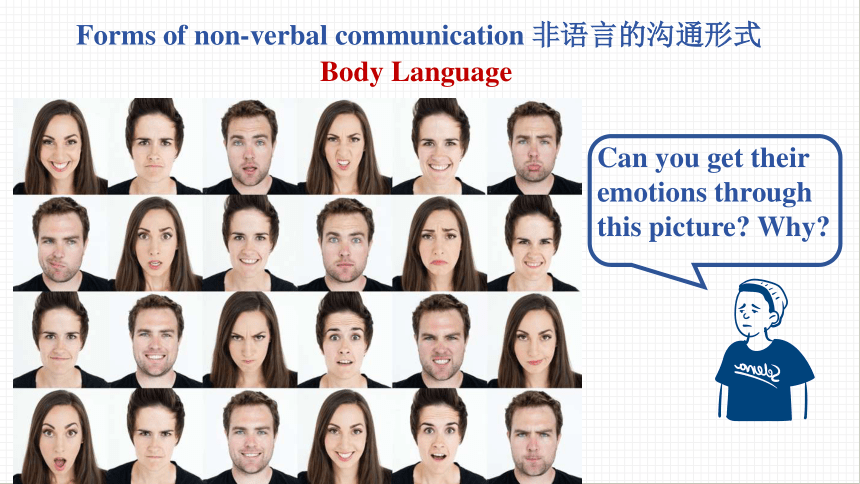
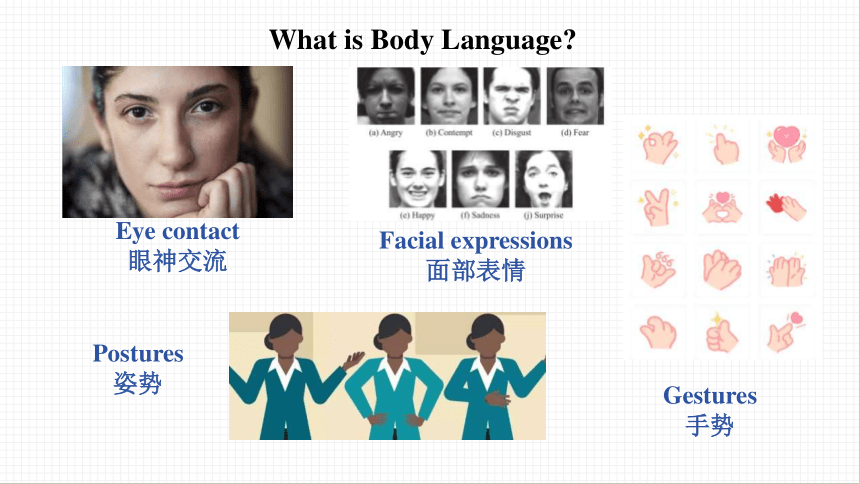
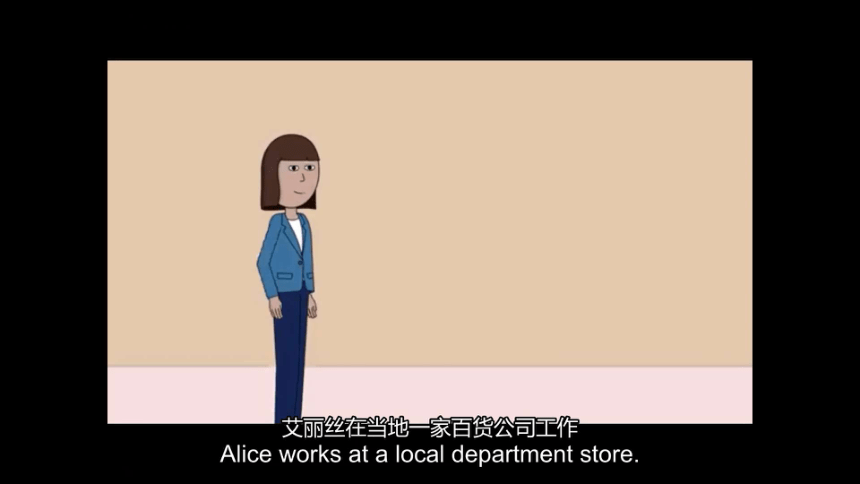
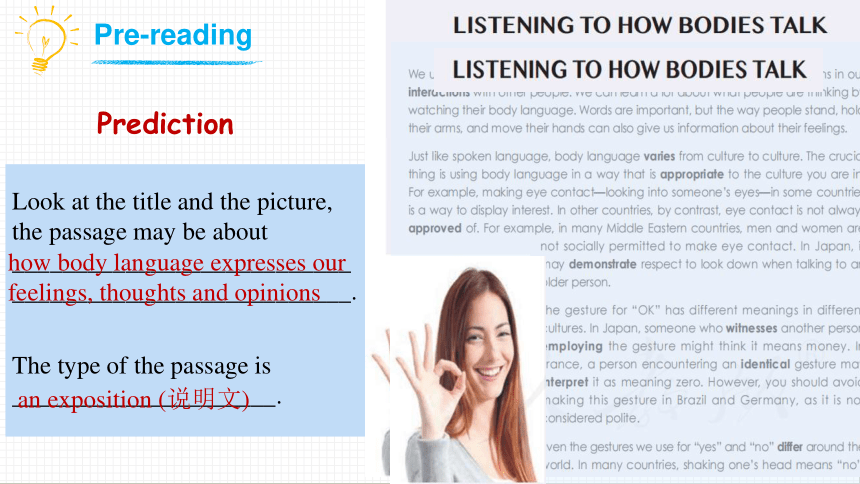
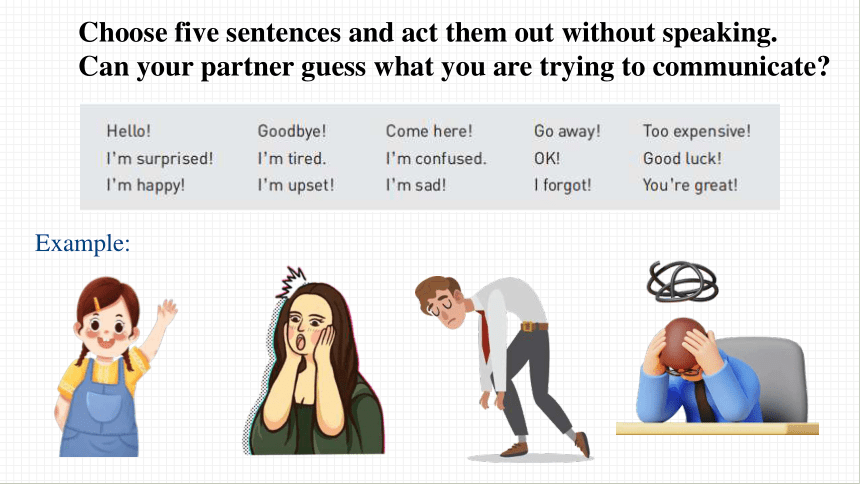
文档简介
(共27张PPT)
Unit 4 Body Language
Reading and Thinking
By the end of this class, you will be able to:
1. get a better understanding of body language by grasping the main points of the passage.
2. develop the ability to identify the topic sentence in a para and figure out the structure of a passage.
3. develop a sense of cross-cultural communication by identifying the feature of body language.
Learning objectives
What I hide by my language, my body utters.
—Roland Barthes
NO!!!
Are you mad at me
Watch and Think.
What does the speaker talk about in the video
Lead-in
Can you get their emotions through this picture Why
Forms of non-verbal communication 非语言的沟通形式
Body Language
What is Body Language
Eye contact
眼神交流
Facial expressions
面部表情
Gestures
手势
Postures
姿势
Prediction
Look at the title and the picture, the passage may be about ______________________________________________________.
how body language expresses our feelings, thoughts and opinions
The type of the passage is _____________________.
an exposition (说明文)
Pre-reading
Choose five sentences and act them out without speaking. Can your partner guess what you are trying to communicate
Example:
Para.1
Para.2
Para.3
Para.4
Para.5
Para.6
Body language plays an important role in daily communication.
Just like spoken language, body language varies from culture to culture.
The gesture for "Ok” has different meanings in different cultures.
Even the gestures we use for "yes "and "no" differ around the world.
Some gestures seem to have the same meaning everywhere.
Some body language has many different uses.
While-reading
Read for main idea
Para.1
Para.2
Para.3
Para.4
Para.5
Para.6
Introduction
The
differences
The
similarities
Different Uses
Read for structure
Part 1 (Para1)
Introduction to body language
Part 2 (Para2-4)
Part 3 (Para 5)
Part 4 (Para 6)
The differences
The similarities
Different uses
总
分
Read for structure
n. 一起活动, 合作
What is the function of the last sentence in Paragraph 1
It is both a topic sentence(主题句)and a transitional sentence(过渡句).
Read for details
Para.1
v. 变化
adj. 适当的,恰当的
v. 核准;认可
Body language Meaning Country/Region
Eye contact between men and women
Looking down when talking to someone
topic sentence
Not polite
Middle East
a sign of respect
Japan
Para.2
vt. 说明,证明,显示,表露
n. 目击者;证人
vt. 雇用
adj. 同一的
vt. 解释;说明
vt. & vi. 口译;翻译
OK sign
Japan
France
Brazil and Germany
Money
Zero
Not polite
topic sentence
Para.3
v. 相异;有区别;不同于
n. 面颊,脸颊
vt. 喜爱
v. 弯腰;鞠躬
n. 腰
Make inferences
Sometimes a passage does not say something directly. However, you can figure it out by looking at the clues in the passage.
What can be inferred from the underline sentences of paragraph 4
In Bulgaria and southern Albania, shaking one’s head means “yes”, and nodding means “no”.
topic sentence
Para.4
Meaning
Country/region
sleep
most places
I’m full
Body language/Gesture
Placing your hands together and resting them on the side of your head while closing your eyes.
Moving your hand in circles over your stomach after a meal.
topic sentence
Para.5
n. 障碍
uses
get through difficult situations
break down barriers
apologise
greet someone
ask for help
find friends
start a conversation
suggestions
smiling at yourself
in the mirror
seeing the smiling face of a good friend
Para.6
Watch the video Smile Trial, and then discuss the questions in groups.
Post-reading
Watch the video Smile Trial, and then discuss the questions in groups.
1. Smiles can be used to hide feelings like anger, fear, or worry. Can you describe a situation where you might smile when you don’t mean it
2. Apart from fake smiles, is there any other kind of body language that can sometimes be fake
3. Which is a more reliable guide for understanding someone’s feelings, their body language or the words they speak
We use both words and body language to express our thoughts and opinions in our interactions with other people. (P38)
在与他人的交往中,我们用话语和肢体语言来表达自己的思想和观点。
interaction / nt r k n/ n. 交流;相互影响
搭配
interaction between performers and their audience 演员和观众之间的互动
the degree of interaction between teacher and student 师生之间交流的程度
例句
Price is determined through the interaction of demand and supply.
价格是通过供需消长而定的。
How would this affect their interactions with others
这会如何影响他们与他人的互动?
Language points
Just like spoken language, body language varies from culture to culture. (P38)
不同的文化有着不同的肢体语言,这与口头语言相似。
vary / ve ri/ vi. (根据情况)变化;改变
搭配
vary from sth to sth 从……到……之间变化
vary slightly 有少许不同
例句
Test scores vary from school to school.
测验成绩各校不同。
Cooking times may vary slightly, depending on your oven.
烹饪时间可能略有不同,因烤炉而异。
The crucial thing is using body language in a way that is appropriate to the culture you are in. (P38)
使用肢体语言时,最重要的是要符合你所处的文化。
appropriate / 'pr pri t/ adj. 合适的;恰当的
搭配
it is appropriate (for sb) to do sth (对某人来说)做某事适宜
例句
Now that the problem has been identified, appropriate action can be taken.
现在既已找出问题的症结,即可采取适当行动。
It would not be appropriate for me to discuss that now.
我现在来讨论那件事不合时宜。
In other countries, by contrast, eye contact is not always approved of. (P38)
相反,在另一些国家,眼神交流并不总是被认可。
approve / 'pru v/ vi. 赞成;同意 vt. 批准;通过
搭配
approve of sb/sth 同意……
例句
Do you approve of my idea
你同意我的想法吗?
The committee unanimously approved the plan.
委员会一致通过了计划。
拓展
disapprove v. 不赞同;反对
In Japan, it may demonstrate respect to look down when talking to an older person.(P38)
在日本,与年长者交谈时,目光下垂表示敬重。
demonstrate /'dem nstre t/ vt. 表现;表达;说明;证明
例句
The study demonstrates the link between poverty and malnutrition.
这项研究证明了贫困与营养不良之间的联系。
The government now has an opportunity to demonstrate its commitment to reform.
政府现在有机会证实其对改革的承诺了。
拓展
demonstration n. 游行,示威;示范,演示
In Japan, someone who witnesses another person employing the gesture might think it means money. (P38)
在日本,一个人看到另外一个人使用这一手势,可能会认为这表示金钱。
witness /'w tn s/ vt. 当场看到;目击;见证 n. 目击者;证人
例句
Several residents claim to have witnessed the attack.
几位居民称目击了这个袭击事件。
Recent years have witnessed a growing social mobility.
近年来人们的社会流动性越来越大。
Police have appealed for witnesses to come forward.
警方呼吁目击者站出来。
Unit 4 Body Language
Reading and Thinking
By the end of this class, you will be able to:
1. get a better understanding of body language by grasping the main points of the passage.
2. develop the ability to identify the topic sentence in a para and figure out the structure of a passage.
3. develop a sense of cross-cultural communication by identifying the feature of body language.
Learning objectives
What I hide by my language, my body utters.
—Roland Barthes
NO!!!
Are you mad at me
Watch and Think.
What does the speaker talk about in the video
Lead-in
Can you get their emotions through this picture Why
Forms of non-verbal communication 非语言的沟通形式
Body Language
What is Body Language
Eye contact
眼神交流
Facial expressions
面部表情
Gestures
手势
Postures
姿势
Prediction
Look at the title and the picture, the passage may be about ______________________________________________________.
how body language expresses our feelings, thoughts and opinions
The type of the passage is _____________________.
an exposition (说明文)
Pre-reading
Choose five sentences and act them out without speaking. Can your partner guess what you are trying to communicate
Example:
Para.1
Para.2
Para.3
Para.4
Para.5
Para.6
Body language plays an important role in daily communication.
Just like spoken language, body language varies from culture to culture.
The gesture for "Ok” has different meanings in different cultures.
Even the gestures we use for "yes "and "no" differ around the world.
Some gestures seem to have the same meaning everywhere.
Some body language has many different uses.
While-reading
Read for main idea
Para.1
Para.2
Para.3
Para.4
Para.5
Para.6
Introduction
The
differences
The
similarities
Different Uses
Read for structure
Part 1 (Para1)
Introduction to body language
Part 2 (Para2-4)
Part 3 (Para 5)
Part 4 (Para 6)
The differences
The similarities
Different uses
总
分
Read for structure
n. 一起活动, 合作
What is the function of the last sentence in Paragraph 1
It is both a topic sentence(主题句)and a transitional sentence(过渡句).
Read for details
Para.1
v. 变化
adj. 适当的,恰当的
v. 核准;认可
Body language Meaning Country/Region
Eye contact between men and women
Looking down when talking to someone
topic sentence
Not polite
Middle East
a sign of respect
Japan
Para.2
vt. 说明,证明,显示,表露
n. 目击者;证人
vt. 雇用
adj. 同一的
vt. 解释;说明
vt. & vi. 口译;翻译
OK sign
Japan
France
Brazil and Germany
Money
Zero
Not polite
topic sentence
Para.3
v. 相异;有区别;不同于
n. 面颊,脸颊
vt. 喜爱
v. 弯腰;鞠躬
n. 腰
Make inferences
Sometimes a passage does not say something directly. However, you can figure it out by looking at the clues in the passage.
What can be inferred from the underline sentences of paragraph 4
In Bulgaria and southern Albania, shaking one’s head means “yes”, and nodding means “no”.
topic sentence
Para.4
Meaning
Country/region
sleep
most places
I’m full
Body language/Gesture
Placing your hands together and resting them on the side of your head while closing your eyes.
Moving your hand in circles over your stomach after a meal.
topic sentence
Para.5
n. 障碍
uses
get through difficult situations
break down barriers
apologise
greet someone
ask for help
find friends
start a conversation
suggestions
smiling at yourself
in the mirror
seeing the smiling face of a good friend
Para.6
Watch the video Smile Trial, and then discuss the questions in groups.
Post-reading
Watch the video Smile Trial, and then discuss the questions in groups.
1. Smiles can be used to hide feelings like anger, fear, or worry. Can you describe a situation where you might smile when you don’t mean it
2. Apart from fake smiles, is there any other kind of body language that can sometimes be fake
3. Which is a more reliable guide for understanding someone’s feelings, their body language or the words they speak
We use both words and body language to express our thoughts and opinions in our interactions with other people. (P38)
在与他人的交往中,我们用话语和肢体语言来表达自己的思想和观点。
interaction / nt r k n/ n. 交流;相互影响
搭配
interaction between performers and their audience 演员和观众之间的互动
the degree of interaction between teacher and student 师生之间交流的程度
例句
Price is determined through the interaction of demand and supply.
价格是通过供需消长而定的。
How would this affect their interactions with others
这会如何影响他们与他人的互动?
Language points
Just like spoken language, body language varies from culture to culture. (P38)
不同的文化有着不同的肢体语言,这与口头语言相似。
vary / ve ri/ vi. (根据情况)变化;改变
搭配
vary from sth to sth 从……到……之间变化
vary slightly 有少许不同
例句
Test scores vary from school to school.
测验成绩各校不同。
Cooking times may vary slightly, depending on your oven.
烹饪时间可能略有不同,因烤炉而异。
The crucial thing is using body language in a way that is appropriate to the culture you are in. (P38)
使用肢体语言时,最重要的是要符合你所处的文化。
appropriate / 'pr pri t/ adj. 合适的;恰当的
搭配
it is appropriate (for sb) to do sth (对某人来说)做某事适宜
例句
Now that the problem has been identified, appropriate action can be taken.
现在既已找出问题的症结,即可采取适当行动。
It would not be appropriate for me to discuss that now.
我现在来讨论那件事不合时宜。
In other countries, by contrast, eye contact is not always approved of. (P38)
相反,在另一些国家,眼神交流并不总是被认可。
approve / 'pru v/ vi. 赞成;同意 vt. 批准;通过
搭配
approve of sb/sth 同意……
例句
Do you approve of my idea
你同意我的想法吗?
The committee unanimously approved the plan.
委员会一致通过了计划。
拓展
disapprove v. 不赞同;反对
In Japan, it may demonstrate respect to look down when talking to an older person.(P38)
在日本,与年长者交谈时,目光下垂表示敬重。
demonstrate /'dem nstre t/ vt. 表现;表达;说明;证明
例句
The study demonstrates the link between poverty and malnutrition.
这项研究证明了贫困与营养不良之间的联系。
The government now has an opportunity to demonstrate its commitment to reform.
政府现在有机会证实其对改革的承诺了。
拓展
demonstration n. 游行,示威;示范,演示
In Japan, someone who witnesses another person employing the gesture might think it means money. (P38)
在日本,一个人看到另外一个人使用这一手势,可能会认为这表示金钱。
witness /'w tn s/ vt. 当场看到;目击;见证 n. 目击者;证人
例句
Several residents claim to have witnessed the attack.
几位居民称目击了这个袭击事件。
Recent years have witnessed a growing social mobility.
近年来人们的社会流动性越来越大。
Police have appealed for witnesses to come forward.
警方呼吁目击者站出来。
